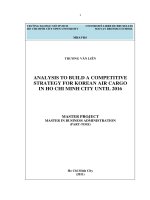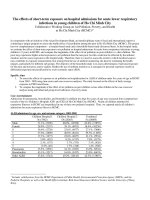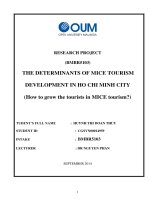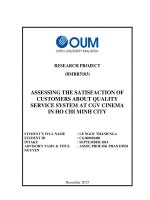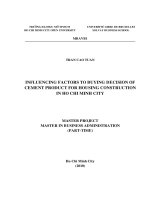Marketing strategy of petrolimex gas JSC for bottled liquefied petrolium gas in Ho Chi Minh city 2012 to 2015
Bạn đang xem bản rút gọn của tài liệu. Xem và tải ngay bản đầy đủ của tài liệu tại đây (1.24 MB, 87 trang )
Dang Tran Hanh Thong i Final Project - MBAVB3
`DECLARATION
I declare that this final project contains no material that has been submitted to any other
program in other institutes, colleges and universities. This work was done by author
except where due reference is made in the text.
`
Signature: DANG TRAN HANH THONG ____________________
Date: Nov.12
th
, 2012___________________________________
Dang Tran Hanh Thong ii Final Project - MBAVB3
ACKNOWLEDGEMENTS
First of all, I would like to acknowledge all professors and coordinators who provided
me valuable knowledge and support at Solvay Business School and Ho Chi Minh City
Open University.
I would like to acknowledge my tutor, Dr Hoang Thi Phuong Thao, for her great
assistance, her value feedbacks help me to find out the way to complete this final
project.
I would like to express my huge thanks to my wife who support me and encourage me
to complete this research.
I would like to acknowledge Board of Director and Sale Department of Petrolimex Gas
Company who help me to collect relevant information and database.
And, I would like to send my thanks to all respondents.
Dang Tran Hanh Thong iv Final Project - MBAVB3
ABSTRACT
Purpose: Thanks for the continued growth economic and people’s living standard in
past years and many years are coming, bottled LPG business in HCMC to be a
potential industry and attracting many suppliers into the market. Consequence, bottled
LPG business industry to be a strong competitive industry, it requests players in the
market have to have the relevant marketing strategies for meeting customer satisfaction
and achieving enterprise goals.
Being one of the most well-known brands in the market, Petrolimex Gas ought to
become a leader in market. However, due to lack of efficiency marketing strategies,
Petrolimex Gas could not achieve market share as expectation and investment.
Research the of relevant marketing concept, marketing strategies and find out the
characteristic of the market, customer purchasing habit, main factors affect to
purchasing decision, customer awareness, then the proposal an efficiency marketing
strategy of Petrolimex Gas for resident household segment is the aim of this study.
Methodology: To achieving the aim of study, the three main theories comprising
Swots, Marketing Strategy and Marketing Mix are applied in this thesis. Moreover,
secondary data are taken from desk research to get competitor in formation, identified
market share and analysis internal information. Primary data are taken from expert
interview for learn more the models of bottled LPG industry and mail survey to
understand the customer behavior and perception of customer toward to current
marketing strategy of Petrolimex Gas.
Conclusion & Recommendation:
Through the findings of research, author understands what are the main factors
influencing and playing the most important for both keeping customer loyalty and
acquiring new customers. Besides, author also understands the customer awareness of
Dang Tran Hanh Thong v Final Project - MBAVB3
Petrolimex Gas brand name vs. other competitor brand names; purchasing habit, and
the perception of customer toward to current marketing strategy of Petrolimex Gas.
After understanding the actual situation of Petrolimex Gas marketing strategy and
market situation, a proposed marketing strategy will be recommended for orienting
marketing activities to Petrolimex Gas JSC in period (2012-2015)
Dang Tran Hanh Thong vi Final Project - MBAVB3
TABLE OF CONTENTS
Declaration and Confidentiality i
Acknowledgment ii
Comments of Guidance Counselor iii
Abstract iv
Table of contents vi
Abbreviation x
List of Tables xi
List of Figures xii
List of Charts xiii
CHAPTER 1 INTRODUCTION
1.1. Project background 1
1.2. Rationale of project and Problem statement 3
1.3. Objective of Project & Scope of Project 5
1.4. Research methodologies 5
1.5. Structure of project 10
CHAPTER 2 LITERATURE REVIEW
2.1 What is the S.W.O.T 11
2.2 Marketing strategy 13
2.2.1 What is marketing strategy 13
2.2.2 Marketing mix strategy 13
Dang Tran Hanh Thong vii Final Project - MBAVB3
2.3 Strategic marketing plan 16
2.3.1 Offensive Strategy 16
2.3.2 Defensive Strategy 18
2.3.3 Market Grow Matrix Strategy 19
2.4 Conclusion 21
CHAPTER 3 COMPANY & MARKET OVERVIEW
3.1. Macro-economic factors 22
3.1.1. Population 22
3.1.2. GDP, GDP/Capita 23
3.2. Bottled LPG market analysis 25
3.2.1. Bottled LPG in household in HCM 26
3.2.2. Current market size & market share 27
3.3. Petrolimex Gas Joint Stock Corporation introduction 29
3.3.1. Vision, Mission, Core value 29
3.3.2. PGC sales performance 29
3.3.3. Current Marketing Strategy of PGC 31
3.4. Competitor analysis 37
3.4.1. Competitor overview. 37
3.4.2. Competitive advantage analysis 41
Dang Tran Hanh Thong viii Final Project - MBAVB3
CHAPTER 4 MARKET RESEARCH FINDING
4.1. Respondents Profile 45
4.2. Brand awareness 46
4.3. Brand usage 47
4.4. Purchasing habit and reason for using bottled LPG 48
4.5. Factor influencing to purchase decision 49
4.6. Reason for switching brand 50
4.7. Customer perception toward to PGC marketing plan 51
4.8. SWOT Analysis 55
CHAPTER 5 PROPOSE MARKETING STRATEGY
5.1 Marketing Objective 57
5.2 Target market 57
5.3 Brand Identity strategy 58
5.4Strategic marketing plan 58
5.5 Marketing mix strategy 59
5.5.1 Product – Customer solution 59
5.5.2 Price – Customer Cost 60
5.5.3. Place – Convenience 61
5.5.4 Promotion – Communication 62
5.6 Developing a revenue plan & marketing budget 63
5.7 Detailed of action plan for one year 64
Dang Tran Hanh Thong ix Final Project - MBAVB3
5.8 Conclusion 65
References I
Appendix I II
Appendix II IV
Appendix III IX
Appendix IV X
Dang Tran Hanh Thong x Final Project - MBAVB3
GLOSSARY OF TERMS AND ABBREVIATIONS
LPG Liquefied Petroleum Gas
PGC Petrolimex Gas Joint Stock Corporation
Petrolimex Vietnam National Petroleum Corporation
GPD Gross Domestic Product
SFEZ Southern Focal Economic Zone
HCMC Ho Chi Minh City
Dang Tran Hanh Thong xi Final Project - MBAVB3
LIST OF TABLES
Table 1.1: Numbers of chosen customers in HCMC 9
Table 3.1: HCMC population 22
Table 3.2: HCMC GDP & GDP per Capital 24
Table 3.3: Sale volume of PGC in HCM in period (2007-2011) 29
Table 3.4: Quantity of Agents in distribution network of PGC in HCM 32
Table 3.5: Allocation margin cost of 12kg-bottled LPG for customer 35
Table 3.6: Comparison of competitor marketing strategy in general 41
Table 3.7: Price comparison 42
Table 3.8: Product comparison 42
Table 3.9: Summarized Competitor Analysis 43
Dang Tran Hanh Thong xii Final Project - MBAVB3
LIST OF FIGURES
Figure 1.1: Market Research Process 6
Figure 2.1: The 4Ps component of marketing mix 15
Figure 2.2: Offensive strategy 17
Figure 2.3: Factors limiting full market development 18
Figure 2.4: Defensive strategy 19
Figure 2.5: Product – Market Growth Matrix 20
Figure 2.6: Strategic Planning Process 21
Figure 3.1: HCMC condominium Supply 23
Figure 3.2: LPG products demand in Vietnam & HCMC 26
Figure 3.3: Distribution network 32
Figure 4.1: Brand Awareness 46
Figure 4.2: Frequency for using a bottled LPG 48
Figure 4.3: Reason for using bottled LPG 49
Figure 4.4: Factors influencing to purchase decision 49
Figure 4.5: Reason for switching brand 51
Figure 4.6: Perception of product 52
Figure 4.7: Perception of Service 52
Figure 4.8: Perception of Price 53
Figure 4.9: Perception of Place 54
Figure 4.10: Perception of Promotion 54
Dang Tran Hanh Thong xiii Final Project - MBAVB3
LIST OF CHARTS
Chart 3.1: Bottled LPG market share in 2010 28
Chart 3.2: Proportion of Sale volume 30
Chart 3.3: Typical Route to Market of PGC’s bottled LPG 31
Chart 3.4: Portion of sale volume in channel 33
Chart 4.1: Demography of respondents 45
Chart 4.2: Factors affect for purchasing decision 50
1
Dang Tran Hanh Thong Final Project
CHAPTER 1
INTRODUCTION
1.1. PROJECT BACKGROUND
LPG product:
Liquefied Petroleum Gas (LPG) is a flammable mixture of propane & butane used
as a fuel in heating appliances from heavy industries: metallurgic, shipbuilding… to
light industries: ceramic, crystal factory… and also in household application such
as: heating, cooking Besides LPG is used to fuel internal combustion engines, it is
often referred to as autogas.
Nowadays, LPG is used popularly in around the world. LPG is replacing other
traditional fuel in some domains such as: cooking, heating, automobile fuel.
Emission if using LPG is cleaner than other sources as diesel, gasoline. Compared
with using electricity and fossil fuel, LPG is also cheaper in some applications
.In Vietnam, LPG in cylinder or bottled LPG is used almost in resident domain and
LPG in tank is used in industrial fields. There are three kinds of LPG product in
bottle: Mini size bottled LPG; medium size 10-13kg bottled LPG and large size 45-
48kg bottled LPG. Depending on the level of consumption of customers, they chose
the suitable item for their own purpose. In general, Mini size bottled LPG mainly
used for portable travel burner, Medium size bottle is used for residential house
hold and big size cylinder is used for restaurant and sometimes for heating in light
industries. The application of big size one in light industry is depended on technical
requirement, design, location of factory and economic condition of customers.
LPG market:
In Vietnam, LPG appeared in South of Vietnam in 1957 with small volume. At that
time, the demand consumption was around 400 tons annually. Until 1975s it was
2
Dang Tran Hanh Thong Final Project
17,000tons LPG per year and was distributed by Esso and Shell. Because of limited
technology; economics and political factors, LPG was temporarily stopped using in
Viet Nam.
LPG was used again in 1990s in household appliance as the luxury fuel with small
quantity. In period 1994-1995, together with economics development; GDP
increased at 8-9%, the living standard has been increasing significantly. Moreover,
Vietnam Government has encouraged using clean fuel boosted the consumption of
LPG in household & industrial appliance. To take these great opportunities, many
corporations took part in this market such as Petrolimex Gas, PV Gas, Saigon Petro,
Shell Gas, Total Gas, Elf Gas… Since then, a new era of this kind of fuel was
begun. According the annual report of Petrolimex Corporation 2010, the total
demand has been increased from 400ton to 250,000tons in period (1991-2000) and
continuously increased up to about 1.2 million tons in 2011. LPG obviously
becomes a popular fuel for heating appliance.
At present, total demand of LPG estimates at 1.2 million tons whilst domestics LPG
manufacturers could produce only 570,000 tons per annual. The shortage is filled by
imported sources from China, Malaysia, Singapore
In Vietnam, LPG is mainly contained in under pressurized steel tank with big
volume and steel bottle with small volume. LPG firms, who are mostly importers,
they supply LPG products to their customers through their distribution network.
Together with the developing economics and population, real estate in general and
resident apartment is also developing quickly in the big cities to match with housing
requirement of Vietnam. It pushes the demand of bottled LPG increase 10%
annually.
As yet, there are about 80 firms who are importers and 1
st
class distributor; a
hundreds of general agents and thousands of agents trading LPG in Vietnam. LPG
3
Dang Tran Hanh Thong Final Project
firms distribute LPG to their agents and industry customers as the end users.
Meanwhile, Agents almost supply LPG in cylinder to resident house unit.
1.2. RATIONALE OF PROJECT AND PROBLEM STATEMENT
Petrolimex Gas Joint Stock Corporation (PGC) Gas company belonging to Vietnam
National Petroleum Corporation (Petrolimex) is a state company established by
Decision No. 1653 – 1988/QD/BTM in December 25th 1998 by the Ministry of
Trade, having registered capital of over 250 Vietnamese billion dongs. Its function
is to import and export liquefied petroleum gas (LPG), distribute LPG in cylinder in
the nationwide, LPG equipments, all services related to technological LPG in civil
& industries Fields.
In Vietnam, PGC have been known as the most famous company in LPG industry
with Petrolimex Gas brand name. PGC is offering to the market both LPG in
cylinders with medium and large size and LPG in tank. Meanwhile, proportion of
LPG in tank takes into account up to 51.27% of total quantity LPG delivered out
market; medium bottled LPG type takes 36.78% and the large size takes 11.95%.
(Petrolimex Gas Report in 2011)
In general, PGC is one of the leading bottled LPG companies of which distribution
network is reached to all of Vietnam provinces and takes nearby 17% market share
in Vietnam.
PGC import one a half of total quantity LPG for company and the balance quantity
is bought from local producers Dinh Co and Dung Quat Processing Plant through
Petro- Vietnam.
As the continuous economic high growth rate and the increase on living standard in
some previous years which is expected to be continued in the future, the
government has encouraged using clean fuel to protect the environment. LPG is
seemed as an integral energy for heating.
4
Dang Tran Hanh Thong Final Project
The above advantage is the foundation for the boom of LPG suppliers with many
brands in Vietnam. It also creates the highly competition in the market. Customers
could easily choose the best supplier who can offer them best price, quality and
services.
Although having strong infrastructure as 7,200 tons capacity LPG storage; well-
known brand name Petrolimex Gas and strong distribution network. The current
marketing strategy of PGC is not really effectively. The sale volume of bottled LPG
products of PGC increased 1% compared with average 10% of growth in 2011.
Especially, Ho Chi Minh City, the most potential market, consumes 20% total
demand nationwide with 240,000MT LPG. In which, 140,000MT was consumed by
resident households who use medium bottled LPG. The industrial households using
large bottled and LPG in bulk bought 100,000MT. However, the PGC‟s sale
volume (in tons) of medium bottled LPG has been unchanged and even being down
5% in period 2006-2011. This effect leads to the decline of market share from 20%
to 4.7% in the period 2001-2011. At present, PGC market share of resident
household segmentation is rather lower than other competitors such as Saigon Petro
(24%); PV Gas ( 8.6%). ) in Ho Chi Minh city market, PGC‟s market share is also
lower than new emerging brands with lower investment Anpha petrol (7%, Gia
Dinh Gas brand name. (Petrolimex Gas Report, 2011)
There should be significant changes if PGC aims to maintain its market share of
resident household segment and survive in tiff competition. After analyzing
business operation of PGC, the author suggests to build a new marketing strategy
for resident household segment to adapt with present situation.
It is obviously that an appropriate marketing strategy can be a foundation for
sustainable growth and create competitive advantages for the firms. As we have
known, an efficiency marketing strategy also creates a differentiation with others
and become an invisible barrier against to other competitors. Therefore, the problem
5
Dang Tran Hanh Thong Final Project
statement can be stated as “What should be an efficiency marketing strategy for
bottled LPG of PGC?”
1.3. OBJECTIVE OF PROJECT AND SCOPE OF PROJECT
Objectives of Project:
Purpose of this project is setting up an efficiency marketing strategy to penetrate
into the bottled LPG market. So some objectives of the project are listed as below:
- To investigate deeply LPG market, the main LPG suppliers and main competitors
also.
- To analyze important marketing factors which drive customers to buy bottled
LPG.
- To propose marketing strategy of PETROLIMEX in period 2012-2015
Scope of Project:
For the limited resource and timing as well, this project is focus on HCM
geography. The scope of this study is household customers, who are using bottled
LPG
This study focus on marketing issue only, not mention to other subjects such as
technology, financial, human resource and so on.
1.4. RESEARCH METHODOLOGY
This project is designed under theories of SWOT, Strategic marketing plan,
marketing and Marketing Mix Strategy of which data is collected from primary and
secondary resource. The research uses multi-methods to collect data such as mail
interview for quantitative research and expert interview for qualitative research.
Secondary data were collected from published documents and internet.
6
Dang Tran Hanh Thong Final Project
Figure1-1: Market Research Process
IDENTIFY
PROBLEM
LITERATURE
REVIEW
SECONDARY DATA
- Macro environment
- Competitors analysis
- Internal analysis
DATA ANALYSIS
MARKET
RESEARCH
RESULT
PROPOSED
MARKETING
STRATEGY
PRIMARY DATA
- Expert interview
- Mail survey
- Drop-off survey
7
Dang Tran Hanh Thong Final Project
Qualitative research interview:
Qualitative research conducted by interviews to experts and sales persons in bottled
LPG business. The purpose of these interviews is to understand the direct
competitor and customer behavior as well as LPG market in general. This
information will be used to create the questionnaire for quantitative research
Quantitative Research:
A Questionnaire related to many issues was sent to users - residential household for
finding and identify brand awareness; customer knowledge of products, customer
purchasing habits; perception about current marketing strategy of PGC and
customer demographics and so on.
The purpose of the quantitative study is to statistically confirm the relationship
between the purchase of LPG and the factors identified through the qualitative
study.
In order to minimize researcher‟s error, a pilot research was carried out as the
beginning. The pilot questionnaire was handled by ten sale man of LPG agent at ten
districts in Ho Chi Minh City. Sale man will interview minimum one end-user
based on questionnaire. After that he will feed back the result to Sale Department of
PGC in Ho Chi Minh. Through the pilot research, the researcher will learn more
about the real situation and adjust questionnaire accordingly.
The next step, the revised questionnaire will be sent by email to 3,000 customers
who are using bottled LPG in Ho Chi Minh area.
Secondary data:
Market research of Petrolimex Gas Corporation, Petrolimex Gas Report from
(2007-2011); World Liquefied Gas Magazine (2010) and Vietnam Gas Association
Report (2010); are used to synthesize and describe the general LPG market
comprising supplier and its segmentation, total demand and forecasted demand in
8
Dang Tran Hanh Thong Final Project
Vietnam. Secondary data related to macroeconomic data is collected from published
documents and internet.
1.4.1 Research question and objectives
For more understanding about customer, the key objectives of market research are
to find out the answer of below question
How about brand awareness of PGC and competitors in LPG bottled
market?
What are the main factors and habits influence to household residents &
agents purchasing behavior?
How do household residents perceive the current marketing program of
PGC?
How about the customer‟s demography?
Research objects design: The objects of market research are persons who
have characteristics below
Males/Females
Using LPG bottled at home
People who are the main decision purchase in household and LPG
agent
Living in Ho chi minh
Questionnaire design:
Questionnaire for household resident (Appendix 2)
Purpose: Finding the brand awareness; reason for using LPG at home;
and factors affecting to purchasing decision, affecting to switching
brand and perceiving of customer toward to current marketing
strategy of PGC
Interview form for expert interview (Appendix 1)
Purpose: Finding the key factors affecting to industry success and
factors affect to customer behaviors
Sample design:
9
Dang Tran Hanh Thong Final Project
Total sample for household resident segment:
Sample size n =
With Z: Standard error associated with chosen level of confidence
(95%)
P: estimated % in the population
q: 100 – p
e: acceptable sample error (3.5%)
This research used cluster sampling technique with fraction of 10,000.
Total population of Ho Chi Minh is about 8million, so the sample size for
this segment should be equal or larger than 800 which are allocated
geographically in Ho Chi Minh City. The questionnaire will be sent by email
to 3,000 people who living in Ho Chi Minh. After that, the number of
respondents will be filtered for equal to the numbers of sample size as below
Table 1.1: Number of chosen customers in HCMC
No
District
Population
Sample
Size
No
District
Population
Sample
size
1
1
187435
19
11
11
232536
23
2
2
140621
14
12
12
427084
43
3
3
188945
19
13
Go Vap
548145
55
4
4
183261
18
14
Tan Binh
430436
43
5
5
174154
17
15
Tan Phu
407924
41
6
6
253474
25
16
Binh Thanh
470054
47
7
7
274828
27
17
Phu Nhuan
175175
18
8
8
418961
42
18
Thu Duc
455899
46
9
9
263486
26
19
Binh Tan
595335
60
10
10
232450
23
20
Suburban
1254965
236
Total Sample Size
800
10
Dang Tran Hanh Thong Final Project
1.5. STRUCTURE OF PROJECT
Project is structured as follows:
Chapter1: Introduction
This chapter provides the general background, rational of project. This chapter also
introduces the project problem statement, objectives of the project. It includes
methodology of research, other related research and organization structure of the
project.
Chapter2. Literature review
This chapter presents some literatures and theory of marketing concepts and
marketing strategies the model to growth business and strategic marketing plan.
Chapter3. Industry back ground – PGC Background – Bottled LPG market
opportunities.
This chapter provides a general introduction of related macro-economic factors and
medium bottled LPG industry. This chapter also provides PGC background
comprising of organization, business operation, and current marketing program of
PGC as well as business performance. Besides, this chapter provides the competitor
analyzed information market opportunities, market trend to develop middle size
bottled LPG in Vietnam.
Chapter 4 Research Methodology and Research Result
This chapter presents the objective of market research, research question, the way to
design market research. It also provides how to collect and analyze data. And
finally it provide the empirical finding of market research
Chapter5 Conclusions and recommendations
This chapter presents the summary of market research. Based on the conclusion the
objectives should be addressed and some recommend, propose an effective
marketing strategy for PGC in Ho Chi Minh
11
Dang Tran Hanh Thong Final Project
CHAPTER II
LITERATURE REVIEW
Generally, the main purpose of literature review is to give readers easy access to
research on a particular topic by selecting high quality articles or studies that are
relevant, meaningful, important and valid and summarizing them into one complete
report.
It provides an excellent starting point for researchers beginning to do research in a
new area by forcing them to summarize, evaluate, and compare original research in
that specific area. It ensures that researchers do not duplicate work that has already
been done.
It can provide clues as to where future research is heading or recommend areas on
which to focus. It identifies inconsistencies, gaps and contradictions in the
literature.
It provides a constructive analysis of the methodologies and approaches of other
researchers.
For the objective and scope of this thesis, which be defined in problem statement, I
just focus on review the literature of marketing field which related and suited to
service business of PGC.
2.1. WHAT IS SWOT
The SWOT analysis is a useful tool for understanding and decision-making for all
sorts of situations in business and organizations. (Businessball 2008)
Kotler stated that the SWOT analysis draws the critical strengths, weakness,
opportunities, and threats (SWOT). SWOT analysis distils these data to show the
critical items from the internal and external audits. The number of items is small for
forceful communications, and they show where a business should focus its
attention. (Kotler et al. 2005, p.58)
External Environment Analysis
12
Dang Tran Hanh Thong Final Project
The external environment analysis comprises of opportunity and threat analysis.
The company needs to identify the main threats and opportunities that their
company faces. The purpose of the analysis is to make the developments that can
have an impact on the firm. The opportunities and threats can consider from the
economic climate, demographic changes, market, technology, competitive activity,
channel pressure, politics etc. (Kotler et al. 2005)
Not all threats call for the same attention or concern – the manager should assess
the likelihood of each threat and the potential damage each could cause. The
manager should then focus on the most probable and harmful threats and prepare
plans in advance to meet them. (Kotler et al. 2005)
Opportunities occur when an environmental trend plays to a company‟s strength.
Each opportunity should be accessed according to its potential attractiveness and
the company‟s probability of success. Companies can rarely find ideal opportunities
that exactly fit their objective and resources. The development of opportunities
involves risks. When evaluating opportunities, the manager must decides whether
the expected return justify these risks. A trend or development can be a threat or an
opportunity, depending on a company‟s strengths. (Kotler et al. 2005)
Internal Environment Analysis
The strengths and weakness in the SWOT analysis do not list all features of a
company, but only those relating to critical success factors. It is nice to be good at
something, but it can be a weakness if the competition is stronger. (Kotler et al.
2005)
13
Dang Tran Hanh Thong Final Project
2.2. MARKETING STRATEGY
2.2.1. What is a marketing strategy?
Any organization wants to exchange its products or services in the marketplace
successfully should have a marketing strategy to guide the allocation resource.
Generally, “A Marketing strategy is the means by which a marketing goal is to be
achieved, usually characterized by a specified target market and a marketing
program to reach it” (Roger A.Kerin; Steven W. Hartley; William Rudelius et al
2007).
In the other words, marketing strategy is a process that can allow an organization to
concentrate its limited resource on the greatest opportunities to increase sale and
achieve a sustainable competitive advantage. A marketing strategy should be
centered on the key concept that customer satisfaction is the main goal.
After studying these theories, author withdraws some conclusion to apply in this
project as follow:
Marketing strategy related to Marketing mix: product; promotion,
distribution, pricing, people
Marketing strategy related to competitive advantages of firms such as
brand name; infrastructure; technology; people
Marketing strategy related to marketing plan as a method and process to
allocate limited company‟s resource to achieve customer satisfaction,
market share, sales goal and competitive advantage in the particular
timeframe
2.2.2. Marketing mix strategies
There are several marketing strategies being applied in firms today, however, author
found that marketing mix is the most suitable tool for this project.
Marketing mix is the set of marketing tools that firms use it to pursue the marketing
object in the target market. Mc Cathy classified into four board group that he called
the four Ps of marketing: Product, Price, Place, and Promotion.



